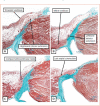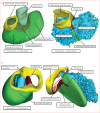Inferior Extensions of the Atrioventricular Node
- PMID: 35106179
- PMCID: PMC8785076
- DOI: 10.15420/aer.2021.43
Inferior Extensions of the Atrioventricular Node
Abstract
The pathways for excitation of the atrioventricular node enter either superiorly, as the so-called 'fast' pathway, or inferiorly as the 'slow' pathway. However, knowledge of the specific anatomical details of these pathways is limited. Most of the experimental studies that established the existence of these pathways were conducted in mammalian hearts, which have subtle differences to human hearts. In this review, the authors summarise their recent experiences investigating human cardiac development, correlating these results with the arrangement of the connections between the atrial myocardium and the compact atrioventricular node as revealed by serial sectioning of adult human hearts. They discuss the contributions made from the atrioventricular canal myocardium, as opposed to the primary ring. Both these rings are incorporated into the atrial vestibules, albeit with the primary ring contributing only to the tricuspid vestibule. The atrial septal cardiomyocytes are relatively late contributors to the nodal inputs. Finally, they relate our findings of human cardiac development to the postnatal arrangement.
Keywords: Conduction tissues; animal species; development; fast pathway; slow pathway.
Copyright © 2021, Radcliffe Cardiology.
Conflict of interest statement
Disclosure: RHA is on the Arrhythmia & Electrophysiology Review editorial board; this did not influence peer review. All other authors have no conflicts of interest to disclose.
Figures











References
-
- Tawara S. Das Reizleitungssystem des Säugetierherzens: eine anatomisch-histologische Studie über das Atrioventrikularbundel und die Purkinjeschen Fäden. Jena: Gustav Fischer 1906
-
- Tawara S. The Conduction System of the Mammalian Heart: An Anatomico-histological Study of the Atrioventricular Bundle and the Purkinje Fibers. 1st English ed. London: Imperial College Press 1998
Publication types
LinkOut - more resources
Full Text Sources

